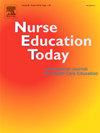用人形图讲病人故事提高护生临床沟通和护理能力的准实验研究。
IF 4.2
2区 医学
Q1 EDUCATION, SCIENTIFIC DISCIPLINES
引用次数: 0
摘要
背景:提高护生的临床沟通和专业能力是提供整体护理的必要条件。叙事性学习,特别是通过讲故事与人形图表等视觉方法相结合,可以加深学生对患者需求的理解,提高护理效果。然而,支持这种方法的经验证据仍然有限。目的:探讨将叙事学习和人形图绘制融入临床教学对护生临床沟通和专业护理能力的影响。设计:准实验研究,采用前测后测对照组设计。研究环境与对象:本研究在台湾某大学进行,共79名护生,分为实验组(n = 40)和对照组(n = 39)。方法:实验组在临床实习期间采用人形图进行为期四周的叙事性干预。采用临床沟通能力量表(CCCS)和护士专业能力量表(NPCS)三个时间点收集数据。采用重复测量方差分析和独立t检验进行分析。结果:实验组CCCS评分(F = 10.853, p 2 = 0.218)和NPCS评分(F = 3.567, p = 0.0033, η2 = 0.084)均较对照组有显著改善。干预显示出中等效应量(CCCS的Cohen’s d = 0.69; NPCS的d = 0.49),表明临床沟通和护理能力有显著改善。结论:将叙事性学习(讲病人的生活故事)与拟人画图结合到临床教学中,能有效提高护生的沟通能力和护理能力。这种方法促进了整体护理,为未来的护理教育和实践提供了一个有希望的方向。本文章由计算机程序翻译,如有差异,请以英文原文为准。
Telling patients' stories with the humanoid diagram to improve nursing students' clinical communication and nursing competence: A quasi-experimental study
Background
Enhancing nursing students' clinical communication and professional competence is essential for delivering holistic care. Narrative learning, particularly through storytelling combined with visual methods such as humanoid diagrams, may deepen students' understanding of patients' needs and improve care outcomes. However, empirical evidence supporting this approach remains limited.
Aim
This study investigated the effects of integrating narrative learning and humanoid diagram drawing into clinical education on nursing students' clinical communication and professional nursing competence.
Design
A quasi-experimental study with a pre-test–post-test control group design.
Setting and participants
The study was conducted at a university in Taiwan and involved 79 third-year nursing students, assigned to an experimental group (n = 40) and a control group (n = 39).
Methods
The experimental group received a four-week narrative-based intervention using humanoid diagram during their clinical practicum. Data were collected at three-time points using validated instruments: the Clinical Communication Competence Scale (CCCS) and the Nurse Professional Competence Scale (NPCS). Repeated measures ANOVA and independent t-tests were used for analysis.
Results
The experimental group showed significant improvements in both CCCS scores (F = 10.853, p < .001, η2 = 0.218) and NPCS scores (F = 3.567, p = .0033, η2 = 0.084) compared to the control group. The intervention demonstrated moderate effect sizes (Cohen's d = 0.69 for CCCS; d = 0.49 for NPCS), indicating significant improvements in clinical communication and nursing competence.
Conclusion
Integrating narrative learning – telling patients' life stories – with humanoid diagram drawing into clinical education effectively enhances nursing students' communication and nursing competence. This approach promotes holistic care and offers a promising direction for future nursing education and practice.
求助全文
通过发布文献求助,成功后即可免费获取论文全文。
去求助
来源期刊

Nurse Education Today
医学-护理
CiteScore
6.90
自引率
12.80%
发文量
349
审稿时长
58 days
期刊介绍:
Nurse Education Today is the leading international journal providing a forum for the publication of high quality original research, review and debate in the discussion of nursing, midwifery and interprofessional health care education, publishing papers which contribute to the advancement of educational theory and pedagogy that support the evidence-based practice for educationalists worldwide. The journal stimulates and values critical scholarly debate on issues that have strategic relevance for leaders of health care education.
The journal publishes the highest quality scholarly contributions reflecting the diversity of people, health and education systems worldwide, by publishing research that employs rigorous methodology as well as by publishing papers that highlight the theoretical underpinnings of education and systems globally. The journal will publish papers that show depth, rigour, originality and high standards of presentation, in particular, work that is original, analytical and constructively critical of both previous work and current initiatives.
Authors are invited to submit original research, systematic and scholarly reviews, and critical papers which will stimulate debate on research, policy, theory or philosophy of nursing and related health care education, and which will meet and develop the journal''s high academic and ethical standards.
 求助内容:
求助内容: 应助结果提醒方式:
应助结果提醒方式:


